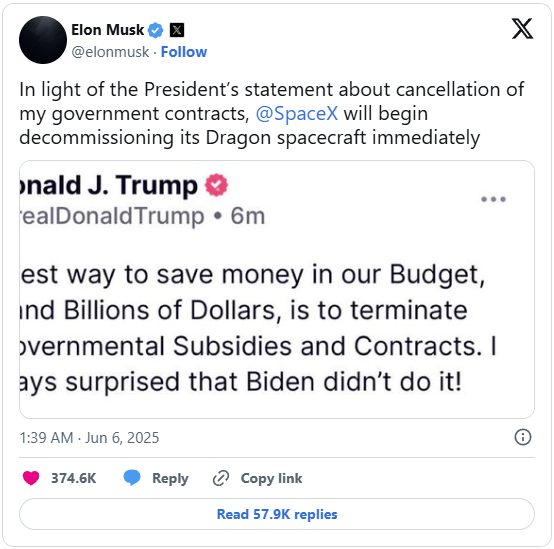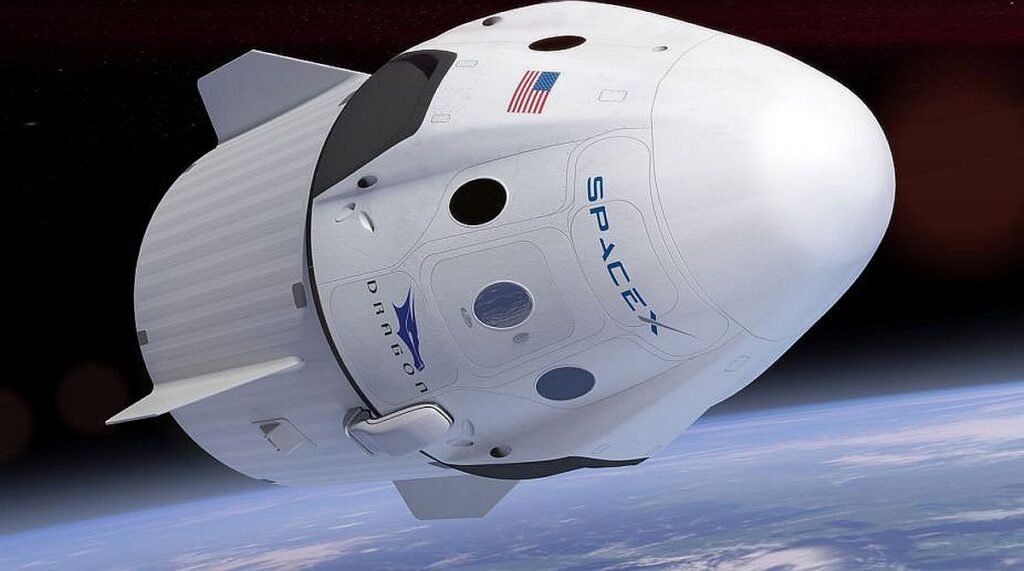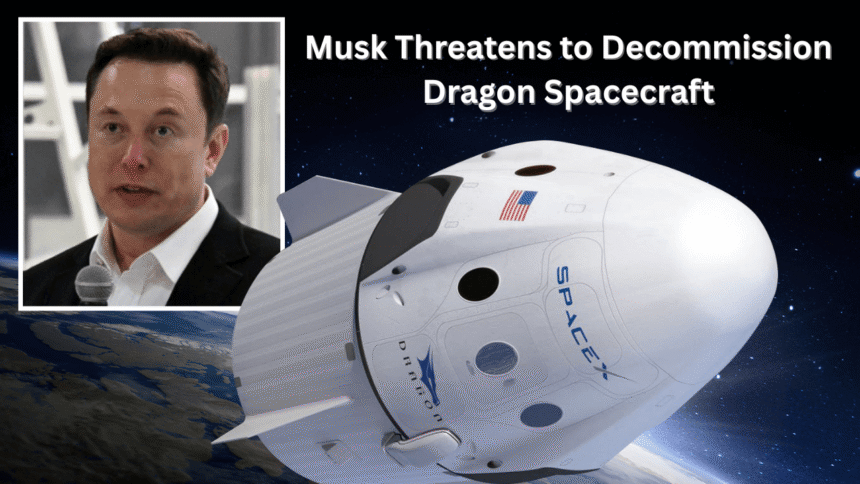SpaceX CEO Elon Musk has recently made headlines by threatening to decommission the company’s flagship spacecraft, Dragon, following a public dispute with former President Donald Trump over federal contract awards. This dramatic announcement has stirred concerns in the aerospace community and among space enthusiasts about the future of NASA’s crewed missions to the International Space Station (ISS).
The Origin of the Dispute
The conflict reportedly began when Trump criticized SpaceX’s handling of certain contracts, hinting at the possibility of redirecting funds away from Musk’s ventures. Musk responded with a strong statement, saying that if the federal government reduces or revokes SpaceX’s contracts, the company would have no choice but to retire the Dragon spacecraft fleet prematurely. This move, Musk warned, would have serious implications for U.S. spaceflight capabilities.

The Dragon spacecraft has been a cornerstone of SpaceX’s partnership with NASA, ferrying astronauts to and from the ISS since 2020. Its reliability and innovation have marked a turning point in commercial spaceflight, breaking a decades-long reliance on Russian Soyuz vehicles. Therefore, Musk’s threat has sent shockwaves through the industry and government agencies alike.
What Does Decommissioning Mean?
Decommissioning a spacecraft like Dragon means permanently retiring it from service. This process would include halting all current missions, stopping future launches, and dismantling or storing existing capsules. Such a decision would not be taken lightly, given the critical role Dragon plays in maintaining America’s presence in low Earth orbit.
If SpaceX follows through with this threat, NASA would lose its primary commercial crew transportation system. The agency would likely face significant delays in crew rotation and cargo delivery to the ISS. Without Dragon, the U.S. could revert to dependence on foreign launch providers, setting back years of progress in space exploration.
The Importance of the Dragon Spacecraft
Since its first crewed flight in May 2020, the Dragon spacecraft has revolutionized how astronauts travel to space. It offers a reusable, cost-effective, and safe alternative to older systems. The vehicle’s autonomous docking capability and spacious interior have earned praise from astronauts and NASA officials.

Moreover, Dragon’s versatility extends beyond crew transport. It also serves as a cargo vehicle, delivering experiments, equipment, and supplies to the ISS. Its frequent flights have ensured the continuous operation of vital research that benefits people on Earth.
Given these benefits, the potential retirement of Dragon is alarming. It highlights how political and financial disputes can have direct consequences on scientific progress and international cooperation in space.
Reactions from NASA and Industry Experts
NASA has remained cautious but clear in its statements regarding Musk’s threat. Agency officials emphasize the importance of the Dragon spacecraft in their ongoing missions and express hope for a resolution that maintains continuity.
Industry experts point out that Musk’s reaction reflects broader challenges faced by commercial space companies dependent on government contracts. “The partnership between government agencies and private companies is complex,” one aerospace analyst remarked. “Funding decisions and political influences can dramatically impact program stability.”
Several experts also highlight that such disputes underscore the need for diversified space transportation options. Relying heavily on a single spacecraft or provider exposes NASA to vulnerabilities in case of contract issues or technical failures.
Elon Musk’s public dispute with former President Trump has caused ripples beyond spaceflight, as tesla faces massive stock dip following Musk-Trump dispute in the financial markets.
What Comes Next for SpaceX and NASA?
At this point, it remains uncertain whether Musk’s threat will materialize. SpaceX has not officially announced plans to retire Dragon, and negotiations with the government may continue behind closed doors. However, the public nature of the dispute has increased scrutiny and speculation.
If the contracts remain intact, Dragon will likely continue to operate and support missions scheduled well into the coming years. These include commercial flights, NASA crew rotations, and potentially new projects related to lunar exploration.
On the other hand, if the contract fallout worsens, SpaceX could shift focus to other projects like the Starship spacecraft. Starship, designed for deep space missions, represents the future of Musk’s vision but is not yet ready to replace Dragon’s role in near-Earth operations.
The Broader Implications for U.S. Space Policy
This situation shines a spotlight on how political dynamics affect space policy and commercial partnerships. Decisions about funding and contract awards are often influenced by broader national priorities and political considerations.
Experts warn that instability in these areas could slow down America’s leadership in space exploration. Maintaining a stable and collaborative environment between government agencies and private companies is crucial for continued innovation.
The Dragon spacecraft saga also raises questions about the resilience of the current space transportation infrastructure. Diversifying launch systems and fostering competition may help mitigate risks associated with such disputes.
Elon Musk’s threat to decommission the Dragon spacecraft amid the contract dispute with Donald Trump has brought to light the fragile balance between politics and progress in space exploration. Dragon’s role as a reliable and pioneering spacecraft has been instrumental in revitalizing NASA’s human spaceflight program.
While the future of Dragon remains uncertain, the situation serves as a reminder that the success of commercial spaceflight depends not only on technology but also on stable partnerships and supportive policies. The coming months will be critical in determining whether Dragon continues to soar or faces an early retirement.

